 PCLinuxOS is a APT-ified, Mandriva-based Linux distribution. It’s one of those distributions that offer a separate version for virtually every existing desktop environment. Four of them – Enlightenment, LXDE, Openbox and Xfce are recommended for intermediate to advanced users, while the GNOME and KDE versions are recommended for all user levels (beginner to advanced).
PCLinuxOS is a APT-ified, Mandriva-based Linux distribution. It’s one of those distributions that offer a separate version for virtually every existing desktop environment. Four of them – Enlightenment, LXDE, Openbox and Xfce are recommended for intermediate to advanced users, while the GNOME and KDE versions are recommended for all user levels (beginner to advanced).
If you make a detailed study of all six versions of this distribution, you are going to question the user-level tagging. But that is the subject of another post. For now, let’s review the KDE version, which was last updated on July 5, 2010.
As with any distribution review, it’s best to start with the installation program.
Installation – The KDE image used for this review is a live CD image. The available boot options are shown in the image below. You get a lot of boot options. While I do not argue with the purpose of a live environment, some people might want to install the distro without first booting into the live environment. It would be a good idea to give those group of users two more options (shown in red in the image).
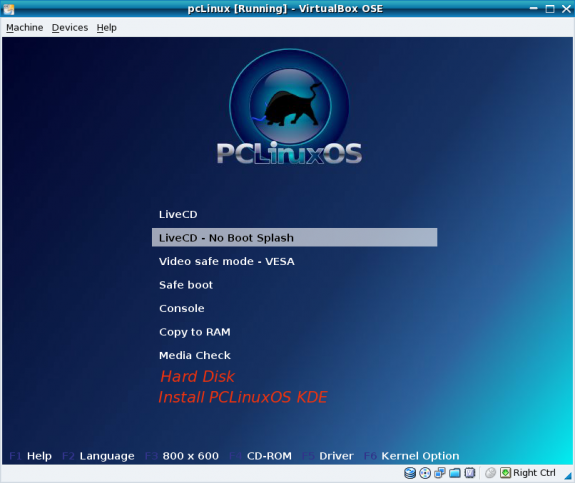
Default boot options plus a couple of suggestions
In contrast, take a look at the boot options of Mandriva One 2010. It is also a live CD, but it offers an option for users who might not want to boot into the live environment, and another option for users who might change their minds about booting or installing from the CD. Most live CD/DVD distributions have these options. It would be a good idea to see them on the next release of PCLinuxOS.

Simple boot options of Mandriva One 2010
Of the major Linux distributions with a live image, PCLinuxOS is, as far as I can recall, the only one that requires a password to install. It’s a requirement that does not make sense to me. It’s not as if the password is hidden or a secret. It’s right there in the middle of the top section of the desktop. I cannot think of a good reason, security or otherwise, why a password is needed to either log into or install a distro from the live environment.
The lack of a Back button at critical steps during the installer process is one very annoying thing, especially if you make a mistake in a previous step. Your only option then is to hit the Cancel button, which means restarting the installation process. All the installers that I have used, even the simplest ones like Ubuntu’s and Mint’s, have a Back button at every step.

Adding a Back button would also be nice
Here’s another instance where an extra button would not hurt. This time, however, it’s not a Back button, but a Cancel button. Imagine for a moment that you are trying to create a partition as shown in the image below. Midway into the operation, you decide against creating the partition. With the installer, you cannot cancel the operation. You will have to complete it, that is, create the partition, then delete it in the main window. Sure, you could click on the window’s close button in the upper right side, but a Cancel button is more professional and expected.
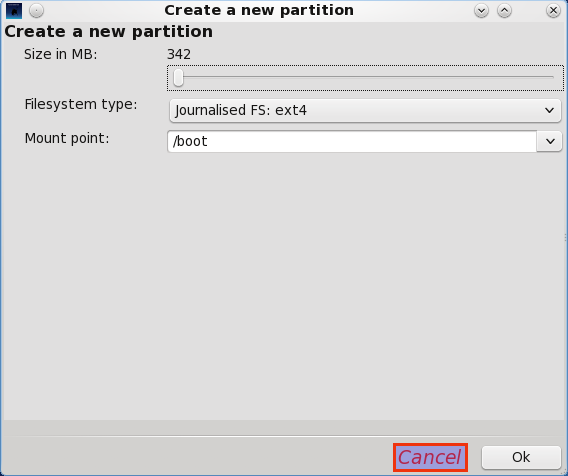
A Cancel button on the partition creation window would be nice, too.
Yet another annoying aspect of the installer is it’s questionable support for LVM. If you didn’t know any better, you’d think that LVM is officially supported, but you’d be wrong. Trying to configure LVM will eventually get you to the step where the message shown in the image below graces your screen. Clicking Ok to install it will keep you waiting from now ’til thy kingdom come. Some people have reportedly succeeded in configuring LVM on PCLinuxOS, but it’s a crap-shoot. Interestingly, the lvm2 package is in the repository, but why is it not packaged with the installer?

Without the LVM2 package, how can you configure LVM?
That’s the end of stuff I do not like about the installer. Actually, there are a few more, but I think these will do for now. What follows is a long list of stuff I also do not like after installation.


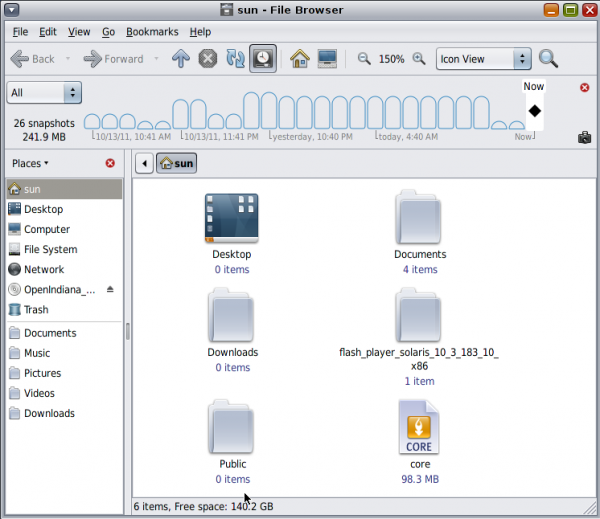
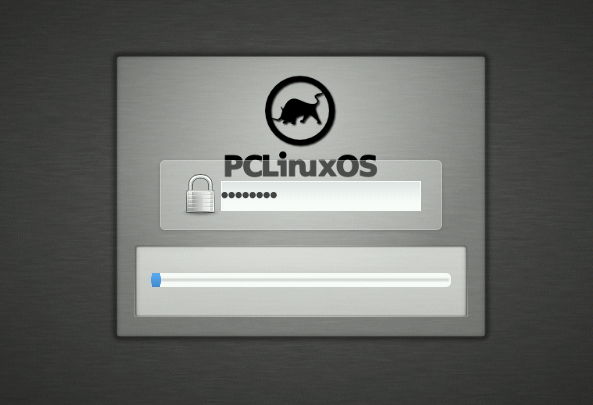
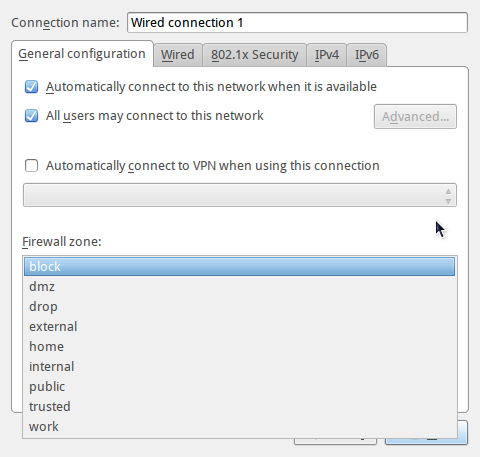
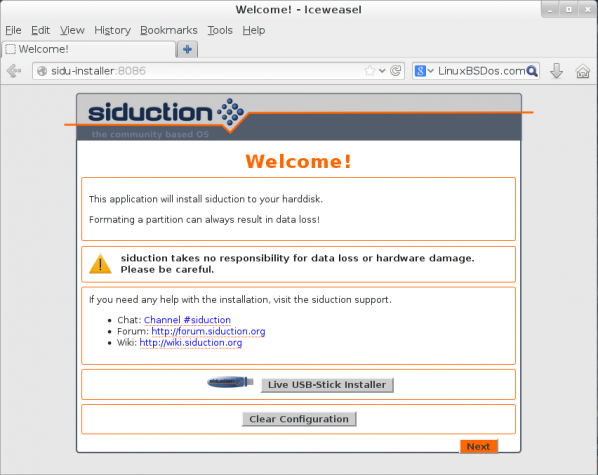


I agree with some points but prefer the firewall icon on the desktop and making my own settings changes.
One thing I didn’t like about the install is that I don’t think it’s possible to install to a flash drive and select ext2. I had to use ext4 which I’d rather not use on a flash drive.
Yes it is possible to format a flash drive with ext2 from the installer. You can also do that from the PCC (PClinux Control Center)
Thanks Debbie Downer!
Obviously this article upset the PCLinuxOS crowd. Good thing it wasn’t posted on their forums where they are “oh so nice”.
It’s about time someone called PCLinuxOS out on all their failures. I hear so often that it is a fantastic distribution but I have yet to see it reach any real stable status. It is stable in the fact that Linux itself is inherently stable. But it lacks the polish of the small things.
All these issues, the installation back buttons, cancel buttons, were because of a but in the Mandriva installer that was later fixed. All the drak tools that PCLinuxOS has been using are outdated, from 2005 or 2006. Somewhere in there. Loads of bug fixes and small feature changes have been made.
Does it still take half a day to boot the distribution?
The installer and drakxtools were ported from a recent release not from cira 2005.
You know what you call as faults are actually defaults chosen by the users of PCLinuxOS. The developers actually listen to their users and make changes based on user feedback.
They prefer Printerdrake to System Configuration Printer.
They prefer the Firewall icon on the desktop so they can configure it themselves based on their own personal needs.
The applications on the LiveCD were selected by the users! How cool is that!
The update notifier was removed from this release because most people found it annoying. PCLinuxOS is updated daily and the notifier was constantly going off.
Have a nice day and yes we do have a right to offer a rebuttal.
P.S. My boot time is less than 25 seconds from grub to desktop.
More than anything else, it’s the logic behind these default configurations that’s at fault. Take your excuse for the firewall, for example: “They prefer the Firewall icon on the desktop so they can configure it themselves based on their own personal needs.” How about a default firewall configuration that makes sense, like enabling it, but allowing all outgoing connections while denying all incoming connections not related to an outgoing one. That is how it is on every distribution with a firewall enabled out of the box.
And if “the update notifier was removed … because most people found it annoying,” how are they being notified of available updates? Like PCLinuxOS, every distribution is updated daily. You could configure update-notifier to check for updates once/day. That way, it won’t be “constantly going off.”
For a REAL review go here.
http://www.linuxjournal.com/content/spotlight-linux-pclinuxos-2010
“For a REAL review go here.”
You mean for a review that we like go here. Can’t handle honesty?
What kind of journalism is this? You found nothing good in PCLinuxOS? What about it being a stable rolling release, well maintained, built in Live CD creator for complete system backup and restore, why is none of this mentioned?
I gave PCLinuxOS KDE to a guy at work that had paid $65.00 twice to have Windows re-installed on his pc, he installed PCLinuxOS all on his own with no problems.
This is not a review, it is just someone bashing PCLinuxOS. I can not believe LinuxToday linked to this crap.
Dude, relax. You are taking this thing too personally. It’s a critical review, done for a purpose, and that is to call to attention stuff I think needs fixing.
“What kind of journalism is this? You found nothing good in PCLinuxOS? What about it being a stable rolling release, well maintained, built in Live CD creator for complete system backup and restore, why is none of this mentioned?”
Did you read the article? He did mention a few good things. A rolling release is not a good thing if not done properly. PCLOS has never done that properly. I’ve seen too many crashes because of the great rolling release. Arch is about the only ones that is close to getting that right and still you have to be careful.
BTW, thanks for letting us post messages without requiring registration, like most sites do nowadays. Thank you.
“PCLinuxOS ships with a good graphical firewall management utility, but why is it disabled by default?”
That firewall is there for paranoids to use, since most users don’t really need it (most of us work behind a router with NAT redirection and hardware-based firewall enabled., don’t we?)
You must have a lot of faith in the firewall on your cable or DSL modem.
Or you must have a lot of faith in a software firewall solution…
I like the PCLinuxOS installer, it is quick and an oem install couldn’t be easier. Comparing PCLinuxOS to Ubuntu is like comparing apples to oranges. Ubuntu is a regression filled disaster. PCLinuxOS has common sense hardware support and I don’t see Ubuntu providing proprietary graphics drivers out of the box like PCLinuxOS and Mandriva. Ubuntu releases could be considered abandon ware because they never fix anything!
I do not want a firewall enabled by default slowing down my system, I have hardware to take care of that. As far as printer support goes, at least I do not have to jump through hoops to install a printer that is not an HP.
I have given PCLinuxOS to several people where I work that have no experience of any kind with Linux, I have yet to hear a single complaint. This review is grasping at straws to try and make PCLinuxOS look bad.
“A firewall enabled by default slowing down my system”? On a desktop machine? I have never heard of anything like that.
This really was not a comparison of the Ubuntu and PCLinuxOS installers. I only mentioned en passant that the Ubuntu installer, like every graphical Linux/BSD installer out there, has a back button at every step of the installation process, while the old Mandriva installer used by PCLinuxOs does not.
“Ubuntu is a regression filled disaster. PCLinuxOS has common sense hardware support and I don’t see Ubuntu providing proprietary graphics drivers out of the box like PCLinuxOS and Mandriva. Ubuntu releases could be considered abandon ware because they never fix anything!”
Now what’s this all about. Instead of talking about the faults of your distro you decide to attack another? Is it to try to draw attention away from the shortcomings of PCLOS? Talk about fanboism.
Ubuntu doesn’t come with an activated firewall. PCLinuxOS puts an icon on the desktop right in front of the user.
“Does Ubuntu have a firewall, and how do I turn it on?” is a popular question among new Ubuntu users. The answer is a bit complicated, but it’s an understandable inquiry for those migrating from the Windows world. WorksWithU addresses that question below by taking a look at Ubuntu’s firewall and some of the tools available for managing it.
We’ll answer the first question first: Ubuntu, like most Linux distributions, ships with a built-in firewall in the form of iptables, so it does indeed have a firewall. However, by default, iptables is not “activated,” in the sense that it’s not configured to do anything besides allow all traffic through.
For most Ubuntu users, that’s probably fine. A normal installation doesn’t have any services running that constitute security risks.
You should not be comparing Ubuntu and your distro. Rather, take a look at the default configuration of Mandriva, the distro that PCLinuxOS was derived from.
Long ago, PCLinuxOS was derived/forked from Mandriva. But that was then, and this is now. PCLinuxOS has matured to an independent distro that stands on its own. As most distros do, PCLinuxOS has borrowed not only from Mandriva, but also Ubuntu, Fedora, openSuse, and many other distros out there. Additionally, PCLinuxOS has created many things in-house, with their own developers. And there is no one better than the genius behind PCLinuxOS than Texstar.
Mandriva is forked from Fedora, Fedora is forked from Red Hat, Ubuntu is forked from Debian … yet we rarely hear that information when referring to those distros. Everyone sees each of them as an independent, free-standing distro, and rightly so. It is now time for everyone to do the same with PCLinuxOS.
Come on, people. He has some valid points. Don’t criticise the review because you can apply all the settings. I installed PCLinuxOS and am happy with it now but:
1. The printer installation thing is strange. It showed up during ionstall while the printer was offline. When I turned it on, it recognised the printer and then wanted to install a raw printer driver!! What is up with that?
2. I had to install twice because during the first install it put all my data on / even though I had made a separate partition for/home. Had never happened before.
3. The addlocale messed up my system language after 2 boots. It took me some reinstalling of different language elements to get it back.
4. The fact that the update notifier is not installed by default is strange. At least you should get a welcome screen to help you onyour way better.
I still like PCLinuxOS and will keep it on my system, but it sure has some rough edges and misses the final touches to really beat Ubuntu and Mint for instance as the most newbie friendly distribution.
Did you get your money’s worth? Geez, what a whiner.
“Did you get your money’s worth? Geez, what a whiner.”
From the review it sounds like it was worth exactly what it cost.
Okay, who’s stealing my nick? I’m the original, and still the best!
Let’s get serious… If you can’t install PCLinuxOS, you’ve got some serious problems. Honestly, boot the Live CD and see if it works on your hardware, and click on the install icon. Just because a distro does something different than your favorite distro, or other distros, does not mean it’s bad or poorly thought out. You’re just used to something else, and it’s foreign. The entire idea behind it is simply testing the distro on your hardware before you try to install it. Then, you can use it while it installs, provided your machine is fast enough.
The installer itself is simply the Mandriva installer. Mandriva prides itself on being the easiest distro to install and use. It’s a great installer. On the flip side, installing Linux Mint, which uses the Ubuntu installer, gave me no option of where to put the bootloader, and it over-wrote my bootloader. I did NOT want that to happen. This is what happens when distros think they know better than the user and dumb things down. Don’t get me wrong, I love Linux Mint, but that’s something I don’t particularly like about it.
This is a pretty biased and poor review, honestly. I think most users, once they adapt from where ever they’ve come from, will enjoy all the nice features PCLinuxOS has to offer. I’m schooled in Linux, using it since 1998, but I really cherish distros like PCLinuxOS and Mandriva that make life simple so that I spend more time USING my Linux than messing with it.
“On the flip side, installing Linux Mint, which uses the Ubuntu installer, gave me no option of where to put the bootloader”
Yes, it does actually. Once you’ve given it the info it needs, it gives you a final screen where you confirm everything is correct, before telling it to proceed. There is an Advanced button, where you can choose where to put the boot loader.
It’s already been brought to your attention that there is an option of where to put the bootloader. Saying you are schooled in Linux and then not knowing how to install a distro properly doesn’t say a lot about that school. Oh well, I guess I’m just being bias.
I, too, found your issues with PCLinuxOS really churlish.
For me it it was the easiest install of an OS that I have ever done.
You carp about LVM; however can you imagine the same person doing a Windows install?
I understand that you have to be critical or you won’t get noticed in the hipster internet world.
Shabby author, just shabby.
I could have written a review filled with lines that glorified how easy it is to configure different aspects of the system, aspects that should have been enabled by default, but what real purpose to the community would that have served. Sometimes you have to be critical of something you love, not just to sound off, but to force a rethink of how the product is packaged.
What we seek is out-of-the-box user-friendliness. That is what has made Apple and its products very successful. Why should I spend about an hour enabling stuff that should have been enabled out of the box? Do you see…?
Amazing though that you bring up Apple’s out-of-the-box user-friendliness. Because Mac OS X defaults to having the firewall disabled (both on 10.5 an on 10.6). The default user does never know this.
At least they finally moved it from “Sharing” to “Security”.
Any OS has things you can nit-pick/criticize about and what annoys one user is the other user’s blessing.
Maybe the latest Mandriva has your cancel or back button in certain screens, but at least on my hardware it boots slower and crashes more often than PCLinuxOS (and I try every new version), so those items are more important to my than a few missing buttons. The developers behind the distro seem to have the head in the right place and put their precious spare time to good use to improve the right portions of the OS.
Use whichever distro works best on your hardware and satisfies your specific needs/niggles/etc. and let everyone try different distros (thanks to the live feature) and decide which one works best on their hardware and their likings.
PCLinuxOS is not a Mandriva based distribution. It ports their installer and Control Center.
How would you know PCLinuxOS is compatible with your system unless you boot it? I guess you want to install to the hard drive only to find it doesn’t work with your hardware. That would be nice wouldn’t it?
OMG screensaver not enabled by default.
Firewall not enabled. Well who knows what services a user might need. Let let them configure it per their needs. Most people these days have no need for a software firewall as most people use routers with built in firewalls.
What average desktop user coming from Windows will ever use or even know what LVM does!
PCLinuxOS is not a static distribution but a rolling release unlike Ubuntu, Fedora and the others you mentioned therefore there isn’t a need for a update notifier. It will just annoy you as there are updates to the distribution daily. If you want it you can install it and have it go off constantly.
This has got to be the most nitpicking worthless review of a distribution I’ve ever seen.